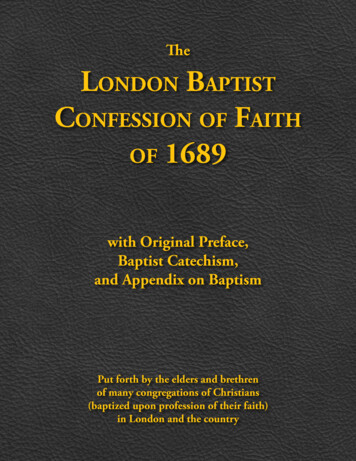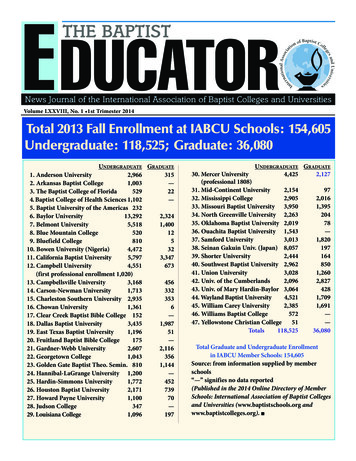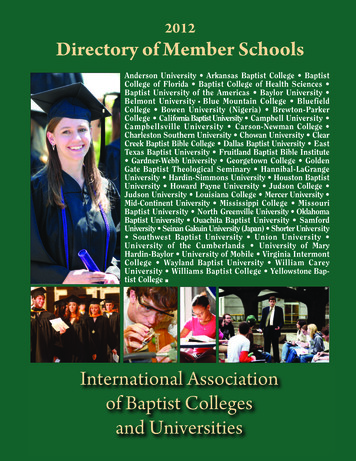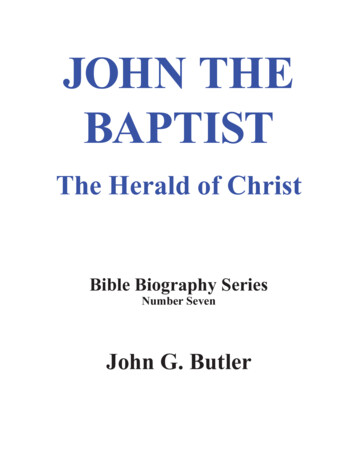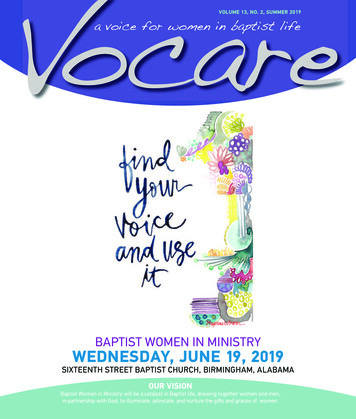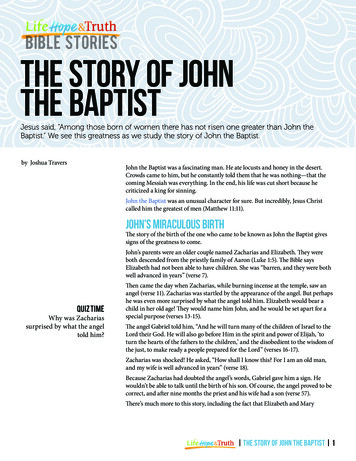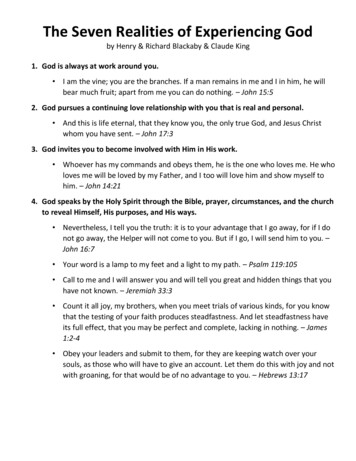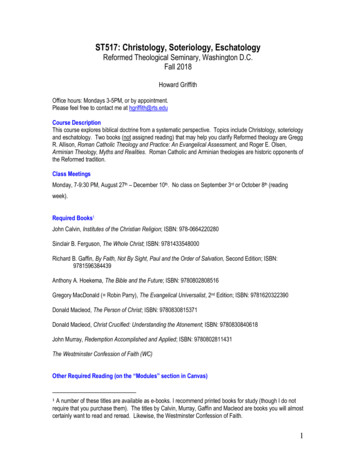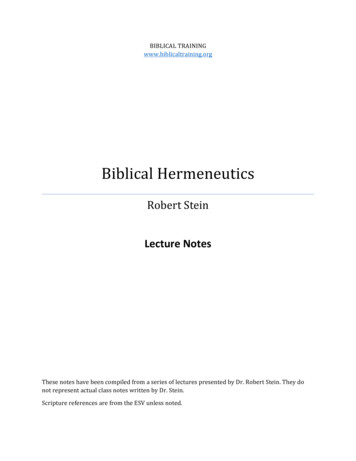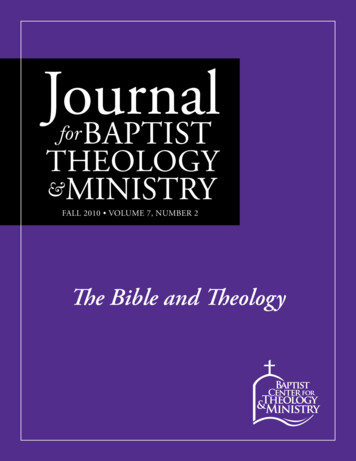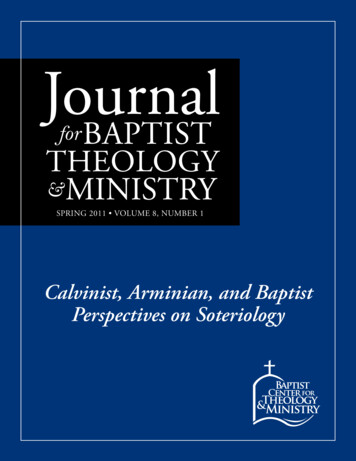
Transcription
SPRING 2011 VOLUME 8, NUMBER 1Calvinist, Arminian, and BaptistPerspectives on Soteriology
CONTENTSJournal for Baptist Theology and MinistrySPRING 2011 Vol. 8, No. 1 The Baptist Center for Theology and MinistryEditor-in-ChiefCharles S. Kelley, Th.D.Associate EditorChristopher J. Black, Ph.D.Assistant EditorSuzanne DavisExecutive Editor &BCTM DirectorSteve W. Lemke, Ph.D.Book Review EditorsPage Brooks, Ph.D.Archie England, Ph.D.Dennis Phelps, Ph.D.Design and Layout EditorsFrank Michael McCormackGary D. MyersCalvinist, Arminian, and BaptistPerspectives on SoteriologyEditorial IntroductionCalvinist, Arminian, and Baptist Perspectives on SoteriologySteve W. Lemke1Part I: Thomas Grantham’s View of SalvationThomas Grantham’s Theology of the Atonement and JustificationJ. Matthew Pinson7RESPONSE to J. Matthew Pinson’s “Thomas Grantham’s Theology of theAtonement and Justification”22Rhyne PutmanRESPONSE to J. Matthew Pinson’s “Thomas Grantham’s Theology of theAtonement and Justification”25Clint BassRESPONSE to J. Matthew Pinson’s “Thomas Grantham’s Theology of theAtonement and Justification”29James LeonardRESPONSE to PanelMatthew Pinson34
CONTENTSPart II: Calvinist and Baptist SoteriologyThe Doctrine of Regeneration in Evangelical Theology: The Reformation to 1800 42Kenneth StewartThe Bible’s Storyline: How it Affects the Doctrine of SalvationHeather A. Kendall59Calvinism and Problematic Readings of New Testament TextsGlen Shellrude69Beyond Calvinism and Arminianism: Toward a Baptist SoteriologyEric Hankins87Joe McKeever’s Cartoon101Book Reviews102Reflections127Back Issues128The Baptist Center for Theology and Ministry is a research institute of New Orleans Baptist TheologicalSeminary. The seminary is located at 3939 Gentilly Blvd., New Orleans, LA 70126.BCTM exists to provide theological and ministerial resources to enrich and energize ministry in Baptistchurches. Our goal is to bring together professor and practitioner to produce and apply these resources toBaptist life, polity, and ministry. The mission of the BCTM is to develop, preserve, and communicate thedistinctive theological identity of Baptists.The Journal for Baptist Theology and Ministry is published semiannually by the Baptist Center forTheology and Ministry. Copyright 2011 The Baptist Center for Theology and Ministry, New OrleansBaptist Theological Seminary. All Rights Reserved.Contact BCTM(800) 662-8701, ext. bmissionsVisit the Baptist Center web site for submission guidelines.
Journal for Baptist Theology and MinistryVol. 8, No. 1 2011EDITORIAL INTRODUCTION:Calvinist, Arminian, and BaptistPerspectives on SoteriologySteve W. Lemke, Ph.D.Dr. Lemke is Provost, Professor of Philosophy and Ethics, occupying the McFarland Chair of Theology,JBTM Executive Editor, and Director of the Baptist Center for Theology and Ministryat New Orleans Baptist Theological Seminaryin New Orleans, Louisiana.To oversimplify a bit, Southern Baptists have two theological tributaries flowing into ourmainstream – the Arminian-leaning General Baptists and the Calvinist-leaning ParticularBaptists. Unto themselves, these tributaries were essentially free-standing streams, independentof each other. The General Baptists were first chronologically, with leaders such as John Smyth,Thomas Helwys, and Thomas Grantham. The name General Baptist came from their belief ina general atonement – that is, that Christ died for all the people who would respond in faith toHim. These Baptists may not have had access to most or all of Arminius’ works, but they were inagreement with many points of his theology. This theological stream was expressed in doctrinalconfessions such as Smyth’s Short Confession of 1610, Helwys’ Declaration of Faith in 1611, theFaith and Practices of 30 Congregations of 1651, and the Standard Confession of 1660. The FreeWill Baptists and General Baptists are the purest contemporary denominational expressions ofthis stream of thought.In contrast, the name of the Particular Baptists was derived from the fact that they believedin a particular (or limited) atonement – that is, Christ died only for particular people, i.e.,the elect. Their best known doctrinal confessions were the 1644 London Baptist Confession(expanded in 1646), the Second London Confession of 1689, and the Philadelphia Confession (ofthe Philadelphia Association) in 1742. The Second London Confession follows the language ofthe Reformed Westminster Confession verbatim (except at points that even Calvinistic Baptistsdiffer from Presbyterians), and the Philadelphia Confession likewise copies the Second LondonConfession almost entirely word for word.However, when these rather pure General Baptist and Particular Baptist streams flowedtogether into what would become the Southern Baptist mainstream, the water became a bitmuddied. After the Great Awakenings, these older streams were mixed with other tributaries,particularly the revivalistic Separate Baptists (sometimes called the “Sandy Creek tradition”).The result was a conglomeration that was not identical to any of these tributaries. After theSecond Great Awakening but long before the Southern Baptist Convention was formed, key
JBTMSteve W. Lemke2Baptist leader John Leland in 1791 described the theology represented in the best of Baptistpulpits in this way in A Letter of Valediction on Leaving Virginia: “I conclude that the eternalpurposes of God and the freedom of the human will are both truths, and it is a matter of factthat the preaching that has been most blessed of God and most profitable to men is the doctrineof sovereign grace mixed with a little of what is called Arminianism.”1This mixture of Calvinism and Arminianism was expressed doctrinally in the New HampshireConfession of 1833, which moved away from the more Calvinistic language of the PhiladelphiaConfession. The New Hampshire Confession became pivotal for Southern Baptist theology in that(a) it was included in even more formative and popular works such as the Baptist Church Manualpublished by J. Newton Brown and the American Baptist Publication Society in 1853, andthe best-selling What Baptists Believe by O. C. S. Wallace in 1913; (b) it became the doctrinalconfession of Southwestern Baptist Theological Seminary at its founding and before thedevelopment of the first Baptist Faith and Message in 1925; and (c) its language and format setthe pattern for all three versions of the Baptist Faith and Message (1925, 1963, and 2000), theofficial doctrinal confession of the Southern Baptist Convention. The more Calvinistic Abstractof Principles was adopted by the founding faculty of Southern Seminary (and later adopted bySoutheastern Seminary), but its impact was much less on overall Baptist theology in that (a) theAbstract has never been approved as a denominational confession by any national meeting ofSouthern Baptists3; (b) the Abstract is fully satisfying to neither Calvinists nor non-Calvinists,since it embraces no more than four points of traditional Calvinist soteriology3; and (c) it wasJohn Leland, “A Letter of Valediction on Leaving Virginia, 1791,” in The Writings of the Late ElderJohn Leland, ed. Louise F. Green (New York: G. W. Wood, 1845), 17212All three SBC seminaries that were founded before the first version of the Baptist Faith and Message in 1925(SBTS, SWBTS, and NOBTS) developed or utilized a confession to guide their faculties -- SBTS had the Abstractof Principles, and NOBTS had the Articles of Religious Belief (each of these developed by the institution’s foundingfaculty), while SWBTS utilized the previously developed New Hampshire Confession. After the Baptist Faith andMessage was approved by the SBC in 1925, SBTS and NOBTS have continued to utilize these confessions thatwere unique to their institutional history as a secondary confession, and the most recent SBC-adopted version of theBaptist Faith and Message as their primary confession. Since the New Hampshire Confession was so close in format andwording to the 1925 Baptist Faith and Message, SWBTS simply used that denominationally approved confessionas its own confession. The Baptist Faith and Message (the 2000 version for most, the 1963 version for a few) is theprimary confession for all six SBC seminaries; for most state conventions, associations, and related entities; and formany SBC-related colleges and universities.3In the official sesquicentennial history of Southern Seminary, Greg Wills describes the Abstract as a fourpoint Calvinist document, omitting the affirmation of belief in limited or particular atonement. See GregWills, Southern Baptist Theological Seminary (1859-2009) (New York: Oxford University Press, 2009), 38.
JBTMSteve W. Lemke3evidently a minority doctrinal confession among Southern Baptists both then and now.4 TheBaptist Faith and Message is the standard confession of the Southern Baptist Convention and ofall its seminaries, a consensus document which merges these streams together.This issue of the Journal for Baptist Theology and Ministry will trace how the Arminian andCalvinistic doctrines of soteriology (the doctrine of salvation) helped shape Baptist beliefs today. Thefirst section addresses the (Arminian) General Baptist theology of Thomas Grantham. The paperentitled “Thomas Grantham’s Theology of Atonement and Justification,” was presented by Dr.Matt Pinson, President of Free Will Baptist Bible College, at a Spring 2011 special event sponsoredby the Baptist Center for Theology and Ministry. Pinson contrasts the General Baptist Grantham’saffirmation of the substitutionary atonement with the view of John Goodwin, who might bedescribed as a Wesleyan Arminian (since Wesley often cited him) and affirmed the governmentalview of the atonement. Grantham and Goodwin represent two poles within Arminian theology –Grantham is a Classical or Reformed Arminian, while Goodwin is a Wesleyan Arminian.The first section also includes the responses of three discussion panel members who interacted withPinson’s paper at the conference. Clint Bass is an Associate Professor of Church History at SouthwestBaptist University in Bolivar, Missouri. Bass earned the Th.M. degree from Duke University, and hisD.Phil. from Oxford University. He is an expert in the thought of Thomas Grantham, having recentlypublished his doctoral dissertation, Thomas Grantham and General Baptist Theology. Jim Leonard is aVisiting Scholar at the H. Milton Haggard Center for New Testament Textual Studies at New OrleansBaptist Theological Seminary, and is a Ph.D. Candidate at St. Edmund’s College of the University ofCambridge. He also serves as Vice President of the Society of Evangelical Arminians. Rhyne Putmanhas earned the M.Div. and Th.M. degrees from New Orleans Baptist Theological Seminary, wherehe is currently completing his Ph.D. dissertation. He serves as an Instructor of Theology at NOBTS.After these responses, Dr. Pinson provides a brief rejoinder to each of these interlocutors.The second section focuses on Calvinist (or Reformed) and Baptist views of soteriology. Thefirst article in this section is a survey of the doctrine of regeneration in evangelical theology fromthe Reformation until 1800, authored by Kenneth Stewart. Dr. Stewart is Professor of Historical Studiesat Covenant College in Lookout Mountain, Georgia, and is author of the recent well-received bookTen Myths about Calvinism: Recovering the Breadth of the Reformed Tradition. Heather Kendall appliesthe Bible’s story line to the doctrine of soteriology, especially Reformed doctrines of soteriology. Ms.4O. C. S. Wallace, whose What Baptist Believe sold nearly 200,000 copies before the creation of the Baptist Faithand Message in 1925, an enormous number at that point in Baptist life, was aware of the Abstract but chose to use theNew Hampshire Confession in his article by article doctrinal study because “it is the formula of Christian truth mostcommonly used as a standard in Baptist churches throughout the country, to express what they believe accordingto the Scriptures.” See O. C. S. Wallace, What Baptists Believe (Nashville: Sunday School Board, 1913), 4). Wallaceincluded the Abstract in an appendix at the end of the book “for helpful comparison and study.” Wallace, 4, 204-208.So, long before the Baptist Faith and Message was written, the Abstract was not the preferred doctrinal confession ofthe majority of Baptists, and evidence from LifeWay Research suggests that the same is true today.
JBTMSteve W. Lemke4Kendall earned an Honours Bachelor of Arts degree from York University, and is a member of New LifeFellowship Baptist Church in Innisfil, Ontario. Glen Shellrude, Professor of New Testament at AllianceTheological Seminary, analyzes New Testament texts that are problematic for Calvinistic theology. Inthe concluding article, Eric Hankins, Pastor of First Baptist Church in Oxford, Mississippi, proposes aBaptist soteriology that is something of a via media between Calvinist and Arminian doctrines, basedon the belief that the biblical notion of election is more nearly corporate election than the election ofindividual believers. We express our appreciation for each of these who have contributed articles to thisissue of the Journal.We would point your attention to three additional items. First of all, we hope you’ll read thepoem memorializing Dr. Alan Day, a fellow of the Baptist Center and for 25 years Pastor of FirstBaptist Church in Edmund, Oklahoma, who suffered an untimely death in an accident. Youcan get a touch of Dr. Day’s heart in his 2001 Founder’s Day Address at New Orleans BaptistTheological Seminary, posted on the Baptist Center website. A poem remembering Dr. Day, inour “Reflections” section, is contributed by Clay Corvin. Second, we commend to you someexcellent book reviews by our reviewers. Thirdly, as always, we appreciate Joe McKeever’s cartoons.You’ll note that this issue 8.1 of the Journal is labeled “Spring 2011.” We apologize again for beingbehind our normal publishing schedule, but we are making a concerted effort to catch up within a fewmonths. The Fall 2010 issue (7.2) came out just a few weeks ago, and we anticipate that the Fall 2011issue (8.2) will be published in about a month. This Fall 2011 issue will be a festschrift in honor of Dr.Dan Holcomb, Senior Professor of Church History at New Orleans Baptist Theological Seminary.Dr. Holcomb announced his retirement this year, and our next issue will feature a series of articlesabout three areas of his great expertise – church history, culture, and the church. We believe you willenjoy this issue. We then hope to release the Spring 2012 issue at the normally scheduled time. Thefocus of the Spring issue will be how Christians interact with the government in the public squarethrough activities such as chaplaincy and faith-based benevolent ministries.Thank you for your readership of the Journal. Let us remind you that the Baptist Center website (http://www.baptistcenter.com/) has many other resources that might be useful to you,including historic Baptist confessions, rare early writings of Baptists and other post-ReformationChristians, back issues of the Journal, and white papers on subjects of interest -- all indexedfor your convenience. If you are interested in interaction on subjects of interest to Baptists, wewould also recommend that you check out the daily articles and comments in the SBC Today blog(http://sbctoday.com). We hope that you find these resources to be helpful for your ministry.Thank you again for your support of the Baptist Center and for the Journal for Baptist Theologyand Ministry!Steve W. Lemke, EditorJournal for Baptist Theology and Ministry
GREER HEARDPOINT–COUNTERPOINT FORUMApril 13-14, 2012Dialogue Participants:Gary HabermasDr. Gary Habermas is Distinguished Research Professor and Chair of the Department of Philosophyand Theology at Liberty University. He holds a PhD in History and Philosophy of Religion fromMichigan State University as well as an MA in Philosophical Theology from the University of Detroit.His main areas of research include the philosophical study of miracles, near-death experiences, thehistorical Jesus, and the historicity of the resurrection of Jesus. Habermas has authored or co-editedover thirty books including The Case for the Resurrection of Jesus (2004), The Risen Jesus and FutureHope (2003), and Beyond Death: Exploring the Evidence for Immortality (1998).Michael Shermeris the Founding Publisher of Skeptic magazine, the Executive Director of the Skeptics Society, amonthly columnist for Scientific American, the host of the Skeptics Distinguished Science LectureSeries at Caltech, and Adjunct Professor at Claremont Graduate University. His many books includeWhy Darwin Matters: The Case Against Intelligent Design (2007), How We Believe: Science,Skepticism, and the Search for God (2000), and Why People Believe Weird Things: Pseudoscience,Superstition, and Other Confusions of Our Time (2002).New Orleans Baptist Theological Seminary3939 Gentilly Blvd. New Orleans, LA 70126For more info and registration go to:www.greerheard.com
PART IThomas Grantham’sView of SalvationAnd He Himself is the propitiationfor our sins, and not for ours only butalso for the whole world.1 John 2:2
JBTMCalvinist, Arminian, and Baptist Perspectives on Soteriology7THOMAS GRANTHAM’S THEOLOGYOF THE ATONEMENT ANDJUSTIFICATIONJ. Matthew Pinson, Ed.D.Dr. Pinson is President of Free Will Baptist Bible Collegein Nashville, Tennessee.IntroductionThomas Grantham, the foremost English General Baptist of the latter half of the seventeenth century,is the quintessential representative of Arminian Baptist theology, combining classical Arminiansoteriology with a distinctly Baptist view of church and state.1 To say, however, that Grantham’s or hisGeneral Baptist contemporaries’ soteriology was Arminian requires much qualification. This is notbecause it differed exceedingly from Arminius’s own soteriology, but because of the shape Arminiantheology took in the early part of the seventeenth century and in the centuries that followed. A study ofGrantham’s theology of the atonement and justification serves not only to enable one to understand thenuances of that unique Arminian Baptist stream of theology, but also to help one grasp the diversity ofArminianism (or, as some have quipped, “Arminianisms”2) as a theological phenomenon.To study Grantham’s views in the context of the whole of Arminian theology prior to himwould be a daunting task.3 But to examine them in the context of a representative English1The English General Baptists are the forefathers of those now known as Free Will Baptists. The earlyFree Will Baptists in the American South were influenced by Grantham’s Christianismus Primitivus, andtheir confession of faith was the Standard Confession, 1660, which Grantham delivered to King Charles IIin 1660 and which he reprinted with annotations in Christianismus Primitivus.2See J. I. Packer, “Arminianisms,” in The Collected Shorter Writings of J. I. Packer, vol. 4, (Carlisle, UK:Paternoster, 1999). In his insightful essay, Packer is right to posit several “Arminianisms,” and to see the differencesbetween Remonstrant and Wesleyan Arminianism. However, he posits all Arminianism as having rejected thedoctrine of a penal satisfaction view of atonement and justification by the imputed righteousness of Christ alone.3The purpose of this essay is not to discuss the five points of Calvinism or the five articles of theRemonstrance, but rather to point up the divergencies that can and do occur within Arminianism. It willbe assumed, for the purposes of this essay, that all Arminians disagree with at least the last four of the fivepoints of Calvinism: unconditional election, particular atonement, irresistible grace, and the unconditionalperseverance of the saints.
JBTMJ. Matthew Pinson8Arminian in the half-century that preceded Grantham would serve at least two purposes. Itwould not only uncover Grantham’s unique middle ground between orthodox Calvinism andwhat has come to be known as Arminianism since the time of Arminius, but it would also serveas a starting point for the discussion of doctrinal Arminianism in the seventeenth and succeedingcenturies. Thus this study will comprise an exposition of Grantham’s doctrines of atonement andjustification with reference to John Goodwin (d. 1665), the Arminian Puritan.4Thomas GranthamThomas Grantham was born in 1634 in Halton, near Spilsby, in eastern Lincolnshire, the sonof a farmer and tailor.5 Grantham made his living, like his father, as a tailor and farmer. Granthamrecalled that the “Lord wrought faith and repentance” in his heart when he was around fourteenor fifteen years of age, and at age nineteen (1653), he joined a small General Baptist church inBoston, Lincolnshire, and was baptized by immersion, as had been the practice of the GeneralBaptists since approximately 1640. Three years after his baptism, in 1656, Grantham was chosenas pastor, which involved him in preaching in his own town as well as neighboring villages. Thisactivity brought persecution upon Grantham and others.In 1660, after the restoration of the monarchy, Grantham and a fellow believer, Joseph Wright,presented a plea for toleration to King Charles II. This plea included a statement of General Baptistloyalty to the crown as well as a confession of faith, which later become known as The StandardConfession, 1660. (Grantham subsequently reprinted it with annotations in his ChristianismusPrimitivus.) The crown was not receptive, and many General Baptist leaders soon found themselvesimprisoned. Grantham himself was in and out of jail during the 1660s, which occasioned his tractThe Prisoner Against the Prelate (1662). In 1666 he was elected a messenger “by the consent of manycongregations, and ordained . . . by those who were in the same office before [him],” in essence aroving minister who helped plant churches, gave counsel to local churches and associations, and4The best general treatment of Grantham is Clint C. Bass’s masterful monograph, Thomas Grantham(1633-1692) and General Baptist Theology (Oxford, UK: Centre for Baptist History and Heritage, 2012).The general nature of his book does not permit his delving into Grantham’s thought on atonement, whichis the chief concern of this essay. However, he correctly understands that Grantham viewed justification asthe imputation of the active and passive obedience of Christ to the believer (see pp. 169-71). While I thinkBass misinterprets Grantham as having a more optimistic anthropology than he actually does regardinghuman reason, depravity, and free will (see pp. 151-64), Bass is quick to note significant differences betweenGrantham and the other Arminians of his day. I believe that, despite Grantham’s anti-predestinarianism,his anthropology is quite pessimistic, like Arminius’s, and closer to the Reformed thought of his day thanto that of most other Arminians. Despite these nuances, Bass’s volume is stellar.5The biographical information in the next three paragraphs is based on Samuel Edward Hester, “AdvancingChristianity to Its Primitive Excellency: The Quest of Thomas Grantham, Early English General Baptist(1634-1692)” (Th.D. diss., New Orleans Baptist Theological Seminary, 1977), 9-32.
JBTMJ. Matthew Pinson9assisted in the ordination of ministers. Grantham then began to establish himself as an author,debater, and pamphleteer. He debated Roman Catholics, Anglicans, Quakers, Presbyterians, andParticular Baptists, and gained a reputation as an able and articulate spokesman for the GeneralBaptists. His most monumental work was Christianismus Primitivus, or, the Ancient ChristianReligion, published in 1678, of which the eminent General Baptist historian Adam Taylor said:“From the universal approbation it received, [it] may be considered almost a public document.”6In this massive work, Grantham aimed to restore primitive Christianity, which he said had beenabused and neglected for centuries. Like Grantham’s other works, Christianismus Primitivus isthe product of a well read theologian who cited numerous contemporary authors but reliedprimarily on the Bible and the church fathers.Grantham’s work as an author and messenger made him the foremost leader of the GeneralBaptists in the latter half of the seventeenth century, and he also gained the respect of manyoutside the General Baptist community. He died on January 17, 1692. Grantham was to beburied in the yard of St. Stephen’s Cathedral in Norwich. Upon rumors that the body would bedug up, John Connould, the vicar of St. Stephen’s, with whom Grantham had previously debatedand become friends, had Grantham’s body interred “before the West Doors, in the Middle Aisle”of the building. Connould conducted the burial service. A plaque in the General Baptist chapelin Norwich contains the following inscription:When at closing the Book he [Connould] addedThis day is a very great man fallen in our Israel:For after their epistolary dispute in sixty letters, endedThat very learned Vicar retained,The highest esteem and friendship for him while living,And was at his own desire buried by him, May MDCCVIII.Grantham’s theology can accurately be described as Arminian because it was strikingly similarto the soteriology of Jacobus Arminius. But Grantham was not fond of the label “Arminian,” justas he did not like the title “Anabaptist,” not because he was unsympathetic with either of thesedoctrinal positions, but because of the negative connotations attached to these names. While“Anabaptist” conjured up images of raving revolutionaries at Munster, “Arminian” invokednotions of semi-pelagianism (if not outright Pelagianism),7 works-righteousness, synergism,Romanism, rationalism, and even Socinianism. Grantham lamented that he was accused of6Cited in David Benedict, A General History of the Baptist Denomination in America and Other Parts ofthe World (New York: Lewis Colby and Company, 1850), 334.7For a discussion of the Pelagian tendencies John Smyth took from the Dutch Waterlander Mennonites,and which Thomas Helwys rejected, see J. Matthew Pinson, “Sin and Redemption in the Theology ofJohn Smyth and Thomas Helwys,” (paper presented at the Theological Symposium of the Commission forTheological Integrity, National Association of Free Will Baptists, 2004), 13-29. Cf. Alvin J. Beachy, TheConcept of Grace in the Radical Reformation (Nieuwkoop: B. De Graaf, 1977).
JBTMJ. Matthew Pinson10preaching “Arminianism, the life and Soul of Popery.” Yet in another place, in a polemic againstthe “dangerous and impious Doctrines of those of Calvin’s Way,” he asserted the “purity of theDoctrine of those called Arminians, concerning the sinful Acts of Men.”8Grantham had read many contemporary Calvinist and Arminian theologians, includingJohn Goodwin, but his General Baptist soteriology was unique among the thinkers of hisday. He differed from the Calvinists in his doctrines of election, the extent of atonement, theresistibility of grace, and the perseverance of the saints. On these subjects he agreed with hisfellow Arminians. Yet he differed substantially with his Arminian counterparts on the doctrinesof sin and depravity, human inability, the nature of atonement and justification by faith, andwhat was involved in falling from grace. Grantham stridently avoided a semi-pelagianism thatwould take the focus off the sovereign grace of God and place it on humanity’s own merit.Hence he differed from traditional Reformed theology in his view of predestination and theresistibility of grace, but not in his understanding of how redemption is accomplished by Godin Christ and applied to the believer.An examination of Grantham’s similarities with Calvinism and his differences with theArminianism of his day defies the contrived classifications usually assigned to Protestantsoteriological positions and gives one insight into the complexities of soteriological thoughtin the post-Reformation period. Consequently, it moves beyond the simplistic “CalvinismArminianism” debate so often discussed in studies of historical theology.John GoodwinThe distinctiveness of Grantham’s soteriology becomes most evident when contrasted withthat of the better known English Arminian, John Goodwin.9 While Grantham and Goodwinwere both known as Arminians, they were far apart on many issues. Grantham was moreradical than Goodwin on matters of ecclesiology, yet Goodwin moved much further fromCalvinist orthodoxy than Grantham did. Goodwin was the chief advocate of what has beenreferred to as the “New Arminianism” or “Radical Arminianism” which took root during theCromwellian era. Though some scholars have assumed that Goodwin’s soteriology exertedgreat influence over other Arminian sectaries, such as the General Baptists, a comparisonof the thought of Grantham and Goodwin demonstrates the inaccuracy of this assumption.108Thomas Grantham, A Dialogue Between the Baptist and the Presbyterian (London, 1691), 27; The InfantsAdvocate (London, 1688), 2.9The best treatment of Goodwin is John Coffey, John Goodwin and the Puritan Revolution: Religion andIntellectual Change in Seventeenth-Century England (Woodbridge, Suffolk, UK: Boydell and Brewer, 2006).10Cf. Ellen More, “John Goodwin and the Origins of the New Arminianism,” The Journal of BritishStudies 22 (Fall 1982), 52.
JBTMJ. Matthew Pinson11Goodwin was educated at Queens’ College, Cambridge, and had by 1633 become vicar ofSt. Stephen’s, Coleman Street, London. By this time, Goodwin had become an Independent,under the influence of John Cotton, and from his pulpit at St. Stephen’s, Goodwin proclaimedhis gospel of nonconformity combined with Arminianism. Precisely when Goodwin embracedanti-Calvinism is a matter of debate, but his magisterial Imputatio Fidei (1642) betrayed anunderstanding of atonement and justification that had moved a great distance from Reformedorthod
first section addresses the (Arminian) General Baptist theology of Thomas Grantham. The paper entitled “Thomas Grantham’s Theology of Atonement and Justification,” was presented by Dr. Matt Pinson, President of Free Will Baptist Bible College, at a Spring 2011 special event s
